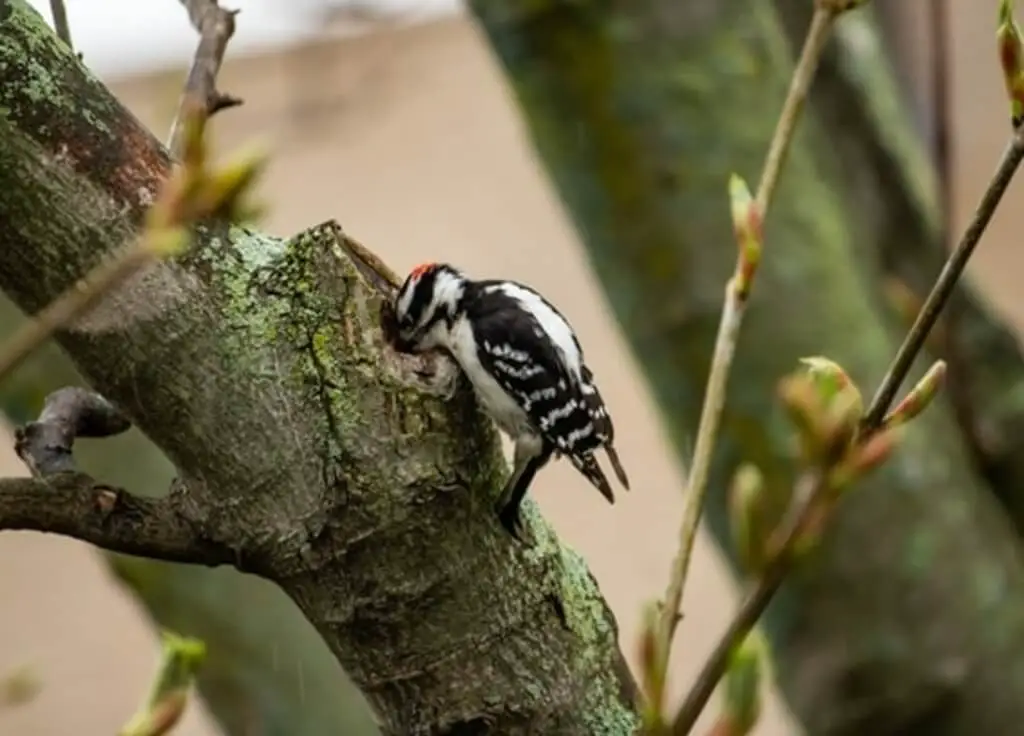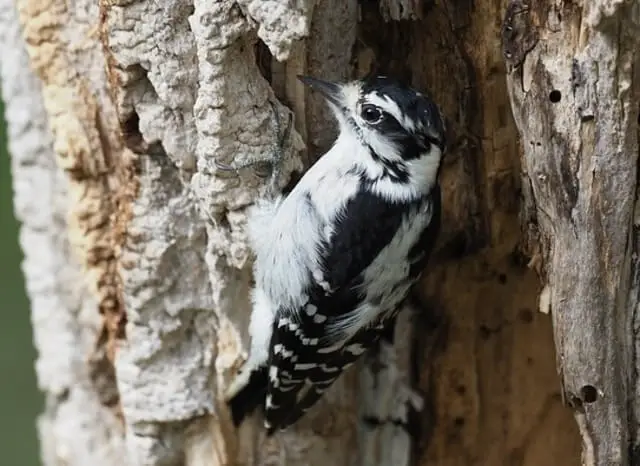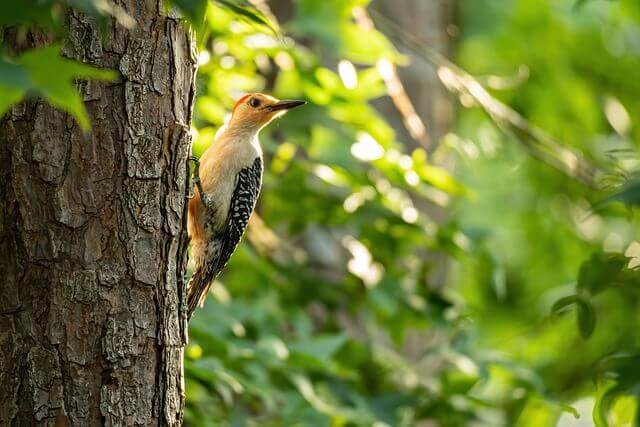Woodpecking is a behavior familiar to many bird enthusiasts, yet the diversity of birds engaging in this activity and their motivations often remain a mystery. In this article, we unveil the intriguing world of woodpeckers and their avian counterparts.
Discover the types of birds that peck wood, unraveling their unique characteristics and preferred habitats. By the end of this read, you’ll be equipped to identify these remarkable birds as they grace your surroundings with their presence.
Table of Contents
- 1 Why Do Birds Engage in This Behavior?
- 2 Types Of Birds That Peck Wood
- 3 Downy Woodpecker
- 4 Pileated Woodpecker
- 5 Hairy Woodpecker
- 6 Northern Flicker
- 7 Red-headed Woodpecker
- 8 Red-bellied Woodpecker
- 9 Acorn Woodpecker
- 10 Yellow-bellied Sapsucker
- 11 Red-breasted Sapsucker
- 12 Red-breasted Nuthatch
- 13 White-breasted Nuthatch
- 14 Carolina Chickadee
- 15 Frequently Asked Questions
- 16 Author
Why Do Birds Engage in This Behavior?
Birds, particularly woodpeckers, engage in pecking on wood for several reasons:
- Foraging: Woodpeckers peck on tree trunks and branches to search for insects, larvae, and other invertebrates hiding beneath the bark. They have specialized bills and tongues designed for extracting prey from crevices.
- Communication: Drumming on wood serves as a form of communication among woodpeckers. They create rhythmic patterns to signal territory boundaries, attract mates, and establish their presence to other birds.
- Nesting: Woodpeckers excavate nesting cavities in trees by pecking and chiseling into the wood. These cavities provide shelter for their young, keeping them safe from predators.
- Food Storage: Some woodpecker species, like the Acorn Woodpecker, use trees as storage units for acorns and other food items. They create small holes and store food in them for future consumption.
- Claiming Territory: Pecking can be a territorial behavior, marking an area as the bird’s own and deterring other birds from encroaching on their space.
- Maintenance: Woodpeckers occasionally peck on wood to maintain their bills. This activity helps keep their bills sharp and in good condition for foraging and excavation.
- Drilling: In addition to searching for insects, woodpeckers may drill holes in trees to access sap, which can be a food source, especially during the spring.
- Social Interaction: Woodpeckers may engage in pecking as a form of social interaction within their flock or family group.
Types Of Birds That Peck Wood
Downy Woodpecker
Downy Woodpeckers are known for their unusual ability to bore into wood, yet they only peck at the surface. The Downy Woodpecker is a small bird that measures about 5.5 – 7.0″ inches in length, and can be found in North America, Europe, Asia and parts of Africa.
They feed on insects such as ants and termites by pecking them out of holes they have bored into trees with their bills. This leaves piles of sawdust on the ground below where these birds were working.
- Range: United States and Canada.
- Habitat: Orchards, parks, forested areas, deciduous woods.
- Length: 6.0 – 7.0″ in. (15.2 – 17.8 cm)
- Weight: 0.7 – 1.02 oz (20-29 g).
- Wingspan: 9.7 – 11.9″ in (24.6 – 30.2 cm).
Pileated Woodpecker
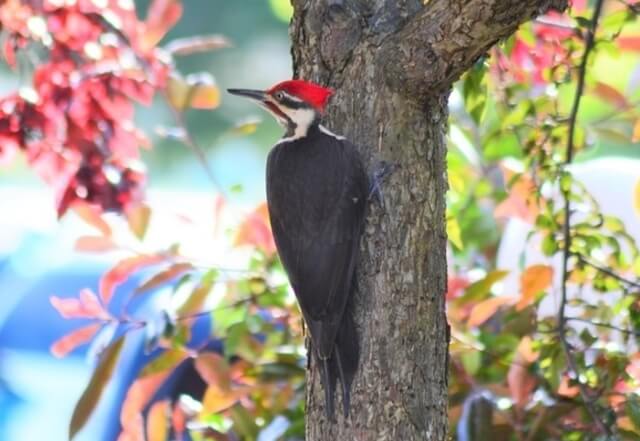
Pileated Woodpeckers are large, black birds that live in the eastern United States. They are known as the largest woodpecker in North America. They are found throughout most of the country, with populations thriving in southern New England and parts of Canada.
Pileated Woodpeckers eat insects, nuts, seeds, berries and fruit. They also have a unique habit of pecking on wood to find food such as carpenter ants or beetle larvae.
- Range: United States, Canada and Mexico.
- Habitat: Forest, tropical forests, wetlands, rural gardens, urban areas.
- Length: 15.3 – 19.5″ in. (39 -49.5 cm).
- Weight: 300 g (11 oz).
- Wingspan: 25 – 30 in (63.5 to 76 cm).
Hairy Woodpecker
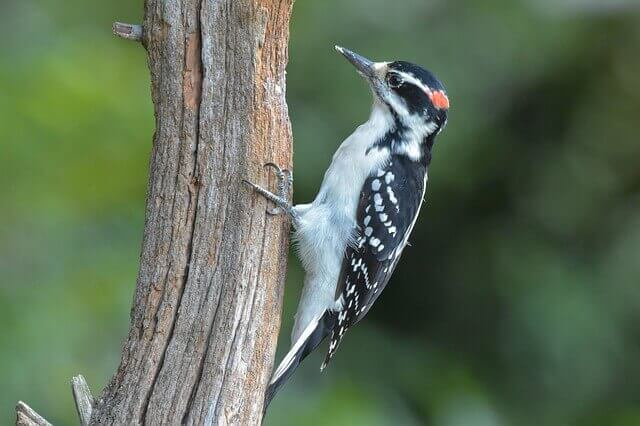
Hairy Woodpeckers are a type of woodpecker that is seen throughout the United States. They love to peck on wood, and can be found chiseling away at trees, telephone poles, and homes. These small woodpeckers peck at trees and wood to get food.
They often go after insects in rotting logs and make holes to live in for shelter from the cold winter months. These birds have hairy feathers on their heads which helps keep them warm during cold winters.
- Range: North and Central America.
- Habitat: Forest edges, open woodlands.
- Length: 6.69 – 10.4 in (17 – 26.5 cm).
- Weight: 42 – 94 g (1.48 – 3.3 oz).
- Wingspan: 13.4 – 17.1″ in. (34 – 43.5 cm).
Northern Flicker
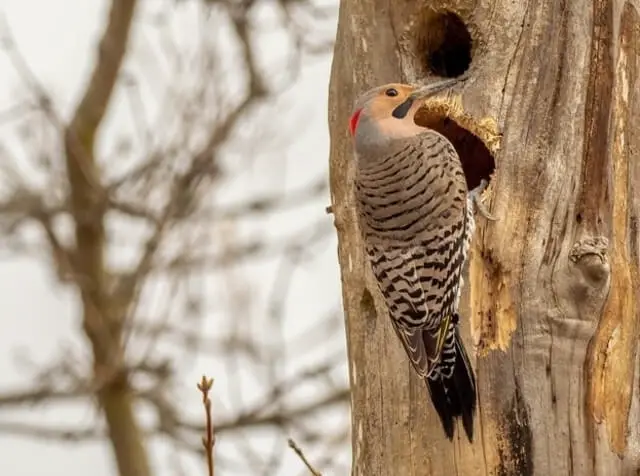
Northern Flickers are common throughout North America. Northern Flickers are a type of woodpecker that love to peck on wood for nesting material and food. This can be seen by the large holes they make in trees, or just about any wooden object.
Flickers have an extremely strong tongue and a strong neck muscle that allows them to keep their head up while drilling into wood. They also have very stiff tail feathers that help support them when they drill into things.
- Range: North America, parts of Central America, Cuba, Cayman Islands.
- Habitat: Woodlands, forest edges, yards, parks, groves, clearings, burnt areas.
- Length: 11 -14.4″ in. (28 -36.5 cm).
- Weight: 86 to 167 g (3.0 to 5.9 oz).
- Wingspan: 16.5 – 21.7″ ( 42–55 cm).
Red-headed Woodpecker
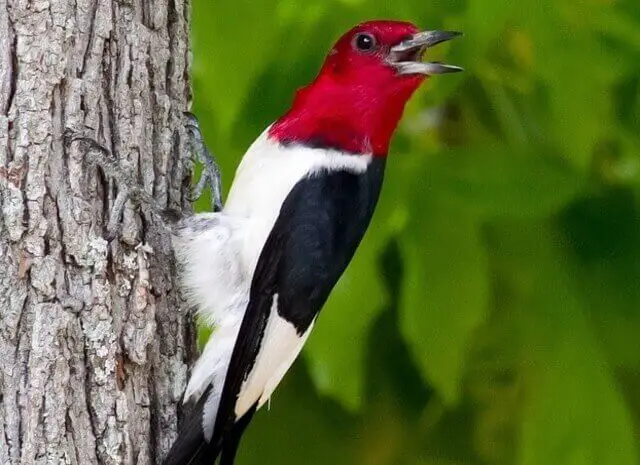
Red-headed Woodpeckers are one of the most recognizable species in North America. In addition to their distinctive red heads, they also have a black back and large white wing patches. Do Red-headed Woodpeckers peck on wood? Yes, but not as much as other woodpecker species.
They are not very good at it because their beaks are designed for climbing trees and eating insects, which makes up about 60% of their diet. They use their long tongue to extract ants from trees or from the ground.
- Range: North America.
- Habitat: Deciduous woodlands, orchards, parks, farmland, forest edges, swamps.
- Length: 7.9 to 10.0″ in. (20 to 25.5 cm).
- Weight: 55 to 98 g (1.9 to 3.5 oz).
- Wingspan: 16.5″ (41.9 cm).
Red-bellied Woodpecker
Red-bellied Woodpeckers are native to North America and range from the southern United States to Canada. They are often seen climbing trees and hammering on dead or dying branches to get insects out from inside them.
The name “red-bellied” comes from their bright red feathers on their chest. Woodpeckers do not peck at living trees, but they will peck holes into rotting logs and stumps to search for food.
- Range: North America, Bahamas.
- Habitat: Forest, savanna, and wetlands.
- Length: 9.00 – 10.51″ in. (22.9 – 26.7 cm).
- Weight: 55 – 90 g (1.9 to 3.17 oz).
- Wingspan: 14.6 – 18.3″ (37 – 46.5 cm).
Acorn Woodpecker
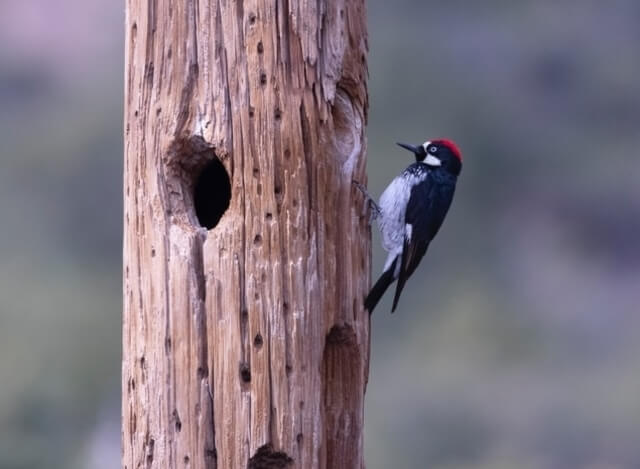
Acorn Woodpeckers are a type of woodpecker that live in the United States. They can be found mainly in southern California, Arizona, New Mexico and Texas. Acorn Woodpeckers peck into trees to get food such as insects or sap from the tree bark.
They also use their bills to drill holes into trees so they store acorns and other nuts inside them. This behavior can cause significant damage to the tree’s surface and weakening its structure over time.
- Range: Oregon, California, southwestern United States, Central America.
- Habitat: Oak and pine-oak woodlands.
- Length: 7.87 – 9.3″ in (20 – 23.5 cm).
- Weight: 2.3 – 3.2 oz (66 – 91 g).
- Wingspan: 13.4 – 16.5″ in (34 – 42 cm).
Yellow-bellied Sapsucker
The yellow-bellied sapsucker feeds by drilling holes in trees to extract sap from tree trunks, branches, or limbs. This common North American bird uses its sharp, barbed tongue to feed on the sweet liquid that it finds deep inside trees.
While they typically peck only once or twice per minute, they will also make quick strikes against other wood surfaces as well, when no sap is available.
- Range: North America.
- Habitat: Forested areas, suburban or urban environments.
- Length: 7.08 – 8.8″ in (18 – 22.5 cm).
- Weight: 1.5 – 1.9 oz (42 – 55 g).
- Wingspan: 13.4 – 16.0″ in (34 – 41 cm).
Red-breasted Sapsucker

The Red-breasted Sapsucker is a North American species of bird that can be found in deciduous and mixed forests. They are best known for drilling holes into the bark of trees to feed on sap from living, healthy trees.
This species uses this beak to create a hole in the bark of trees, where it will then feed off sap. They can also use their beaks to peel away pieces of bark and wood in order to get at the softer parts underneath.
- Range: Alaska, British Columbia, Washington, Oregon, California.
- Habitat: Coniferous forests.
- Length: 7.7 – 8.8″ in (19.5 – 22.5 cm).
- Weight: 1.87 – 2.24 oz (53 – 63.5 g).
- Wingspan: 14.6 – 15.9″ in (37 – 40.5 cm).
Red-breasted Nuthatch
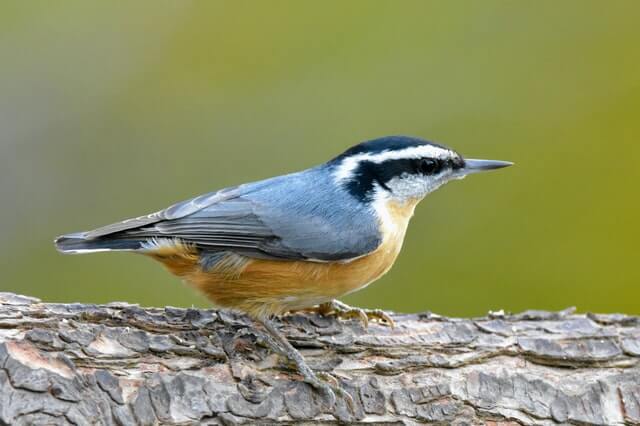
The Red-breasted Nuthatch lives in North America and breeds from the Eastern United States to British Columbia, Canada. They prefer to live in coniferous trees, and are most active in the winter months.
The Red-breasted Nuthatch are omnivores and feed on seeds, nuts, insects, larvae and spiders which they find by pecking at the bark of trees or by climbing high into the tree canopy to look for food.
- Range: North America
- Habitat: Dense coniferous forest
- Length: 4.1 – 4.5″ in (10.4 – 11.4 cm)
- Weight: 0.26 – 0.47 oz (7.5 – 13.2 g).
- Wingspan: 7.0 – 8.0″ in (17.8 – 20.3 cm).
White-breasted Nuthatch

The White-breasted Nuthatch is a bird that likes to live in trees and feed on the seeds of pine cones. In order to get at these tasty treats, they will peck away at them until they break open.
Do White-breasted Nuthatches peck on wood? Well, not only do they use their beaks to find food, but they also use it for other things such as drumming out an alarm or attracting mates.
- Range: North America, Mexico.
- Habitat: Mature woods, deciduous than coniferous forests, woodlands, parks.
- Length: 4.7 – 5.5 in (12 – 14 cm).
- Weight: 0.63 – 1.0 oz (18 – 31 g).
- Wingspan: 7.8 – 11 in (20 – 28 cm).
Carolina Chickadee
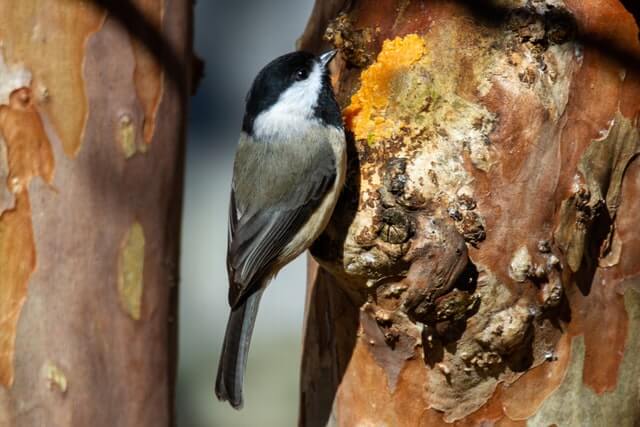
Carolina Chickadees are one of the most common and familiar birds in North America. They have a wide range of habitats, from woodlands to urban areas. Some people wonder if Carolina Chickadees peck on wood as part of their natural behavior.
It is true that they often peck at soft wood or a rotten or deteriorated section of a tree. However, this type of activity is usually only done when creating a nest or when food sources are scarce.
- Range: Eastern part of North America.
- Habitat: Coniferous forests, deciduous forests, urban areas, and mixed woodlands.
- Length: 4.3 – 5.1 in (11 – 13 cm).
- Weight: 8.8 – 11.6 g (0.31 – 0.41 oz).
- Wingspan: 6.3 – 8.3 in (15 – 21 cm).
Frequently Asked Questions
What birds peck holes in houses?
Many birds are known to peck holes in houses. Flickers, woodpeckers, chickadees and nuthatches all have been known to create damage to structures through their incessant need for nesting material.
What does it mean when a woodpecker is pecking at your house?
Woodpeckers are in the habit of pecking on homes, often causing structural damage. They do this for two reasons: to find food and to attract mates.
Can woodpeckers peck through steel siding?
Woodpeckers are often associated with pecking through wood. This might lead you to believe that they can also penetrate steel siding, but this is not the case. Steel siding is designed to be more durable than regular wood, and it cannot be penetrated by a woodpecker’s bill.
Do woodpeckers strip bark off trees?
The typical way a woodpecker removes bark is by tapping on the tree in search of insects and other invertebrates living beneath it. This makes an oval-shaped area where the hard outer layer has been removed, leaving softer inner layers exposed.
Why do sapsuckers drill holes in trees?
The sapsucker, drills holes in trees to extract sap and other nutrients from the tree. The holes can range from 1-5 cm deep, and they vary in size depending on what type of tree is being drilled into.

